light FIAT 500 2020 Owner handbook (in English)
[x] Cancel search | Manufacturer: FIAT, Model Year: 2020, Model line: 500, Model: FIAT 500 2020Pages: 228, PDF Size: 6.01 MB
Page 104 of 228
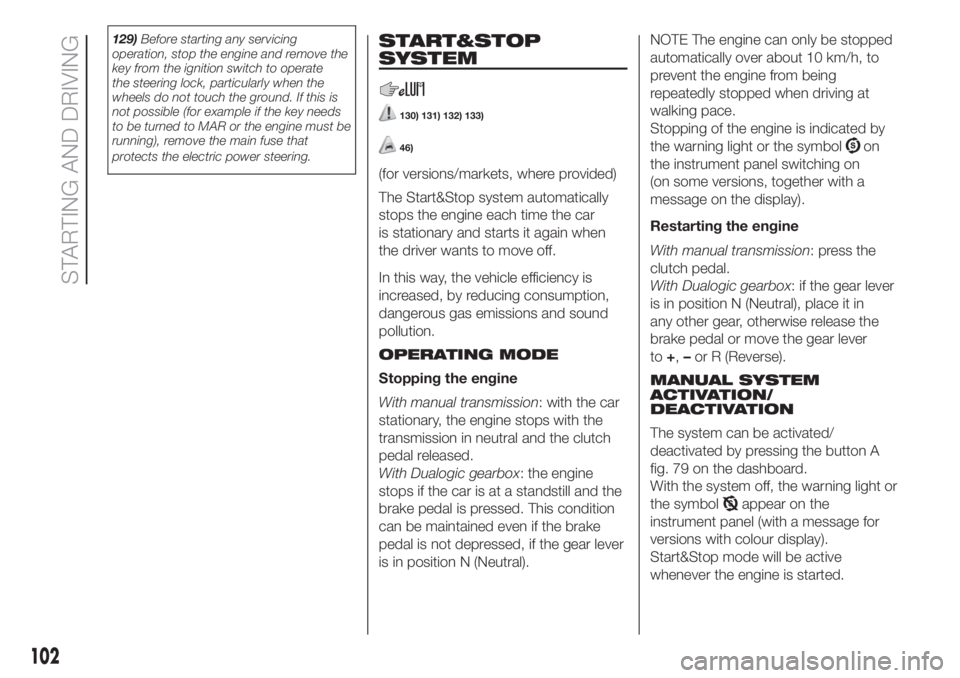
129)Before starting any servicing
operation, stop the engine and remove the
key from the ignition switch to operate
the steering lock, particularly when the
wheels do not touch the ground. If this is
not possible (for example if the key needs
to be turned to MAR or the engine must be
running), remove the main fuse that
protects the electric power steering.START&STOP
SYSTEM
130) 131) 132) 133)
46)
(for versions/markets, where provided)
The Start&Stop system automatically
stops the engine each time the car
is stationary and starts it again when
the driver wants to move off.
In this way, the vehicle efficiency is
increased, by reducing consumption,
dangerous gas emissions and sound
pollution.
OPERATING MODE
Stopping the engine
With manual transmission: with the car
stationary, the engine stops with the
transmission in neutral and the clutch
pedal released.
With Dualogic gearbox: the engine
stops if the car is at a standstill and the
brake pedal is pressed. This condition
can be maintained even if the brake
pedal is not depressed, if the gear lever
is in position N (Neutral).NOTE The engine can only be stopped
automatically over about 10 km/h, to
prevent the engine from being
repeatedly stopped when driving at
walking pace.
Stopping of the engine is indicated by
the warning light or the symbol
on
the instrument panel switching on
(on some versions, together with a
message on the display).
Restarting the engine
With manual transmission: press the
clutch pedal.
With Dualogic gearbox: if the gear lever
is in position N (Neutral), place it in
any other gear, otherwise release the
brake pedal or move the gear lever
to+,–or R (Reverse).
MANUAL SYSTEM
ACTIVATION/
DEACTIVATION
The system can be activated/
deactivated by pressing the button A
fig. 79 on the dashboard.
With the system off, the warning light or
the symbol
appear on the
instrument panel (with a message for
versions with colour display).
Start&Stop mode will be active
whenever the engine is started.
102
STARTING AND DRIVING
Page 107 of 228
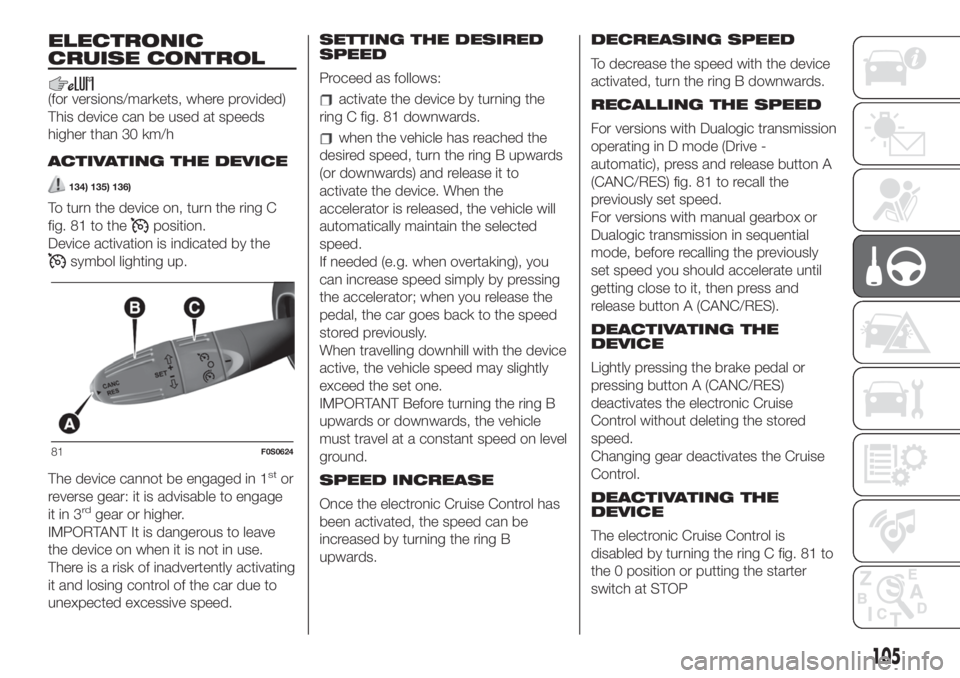
ELECTRONIC
CRUISE CONTROL
(for versions/markets, where provided)
This device can be used at speeds
higher than 30 km/h
ACTIVATING THE DEVICE
134) 135) 136)
To turn the device on, turn the ring C
fig. 81 to the
position.
Device activation is indicated by the
symbol lighting up.
The device cannot be engaged in 1
stor
reverse gear: it is advisable to engage
it in 3
rdgear or higher.
IMPORTANT It is dangerous to leave
the device on when it is not in use.
There is a risk of inadvertently activating
it and losing control of the car due to
unexpected excessive speed.SETTING THE DESIRED
SPEED
Proceed as follows:
activate the device by turning the
ring C fig. 81 downwards.
when the vehicle has reached the
desired speed, turn the ring B upwards
(or downwards) and release it to
activate the device. When the
accelerator is released, the vehicle will
automatically maintain the selected
speed.
If needed (e.g. when overtaking), you
can increase speed simply by pressing
the accelerator; when you release the
pedal, the car goes back to the speed
stored previously.
When travelling downhill with the device
active, the vehicle speed may slightly
exceed the set one.
IMPORTANT Before turning the ring B
upwards or downwards, the vehicle
must travel at a constant speed on level
ground.
SPEED INCREASE
Once the electronic Cruise Control has
been activated, the speed can be
increased by turning the ring B
upwards.DECREASING SPEED
To decrease the speed with the device
activated, turn the ring B downwards.
RECALLING THE SPEED
For versions with Dualogic transmission
operating in D mode (Drive -
automatic), press and release button A
(CANC/RES) fig. 81 to recall the
previously set speed.
For versions with manual gearbox or
Dualogic transmission in sequential
mode, before recalling the previously
set speed you should accelerate until
getting close to it, then press and
release button A (CANC/RES).
DEACTIVATING THE
DEVICE
Lightly pressing the brake pedal or
pressing button A (CANC/RES)
deactivates the electronic Cruise
Control without deleting the stored
speed.
Changing gear deactivates the Cruise
Control.
DEACTIVATING THE
DEVICE
The electronic Cruise Control is
disabled by turning the ring C fig. 81 to
the 0 position or putting the starter
switch at STOP
81F0S0624
105
Page 109 of 228
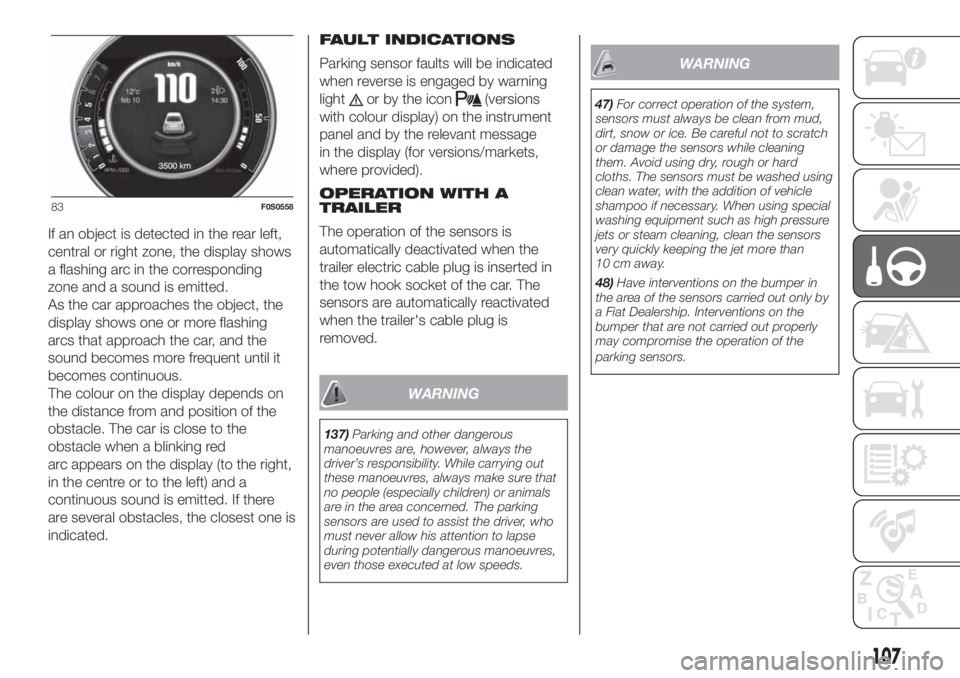
If an object is detected in the rear left,
central or right zone, the display shows
a flashing arc in the corresponding
zone and a sound is emitted.
As the car approaches the object, the
display shows one or more flashing
arcs that approach the car, and the
sound becomes more frequent until it
becomes continuous.
The colour on the display depends on
the distance from and position of the
obstacle. The car is close to the
obstacle when a blinking red
arc appears on the display (to the right,
in the centre or to the left) and a
continuous sound is emitted. If there
are several obstacles, the closest one is
indicated.FAULT INDICATIONS
Parking sensor faults will be indicated
when reverse is engaged by warning
light
or by the icon(versions
with colour display) on the instrument
panel and by the relevant message
in the display (for versions/markets,
where provided).
OPERATION WITH A
TRAILER
The operation of the sensors is
automatically deactivated when the
trailer electric cable plug is inserted in
the tow hook socket of the car. The
sensors are automatically reactivated
when the trailer's cable plug is
removed.
WARNING
137)Parking and other dangerous
manoeuvres are, however, always the
driver’s responsibility. While carrying out
these manoeuvres, always make sure that
no people (especially children) or animals
are in the area concerned. The parking
sensors are used to assist the driver, who
must never allow his attention to lapse
during potentially dangerous manoeuvres,
even those executed at low speeds.
WARNING
47)For correct operation of the system,
sensors must always be clean from mud,
dirt, snow or ice. Be careful not to scratch
or damage the sensors while cleaning
them. Avoid using dry, rough or hard
cloths. The sensors must be washed using
clean water, with the addition of vehicle
shampoo if necessary. When using special
washing equipment such as high pressure
jets or steam cleaning, clean the sensors
very quickly keeping the jet more than
10 cm away.
48)Have interventions on the bumper in
the area of the sensors carried out only by
a Fiat Dealership. Interventions on the
bumper that are not carried out properly
may compromise the operation of the
parking sensors.
83F0S0558
107
Page 110 of 228
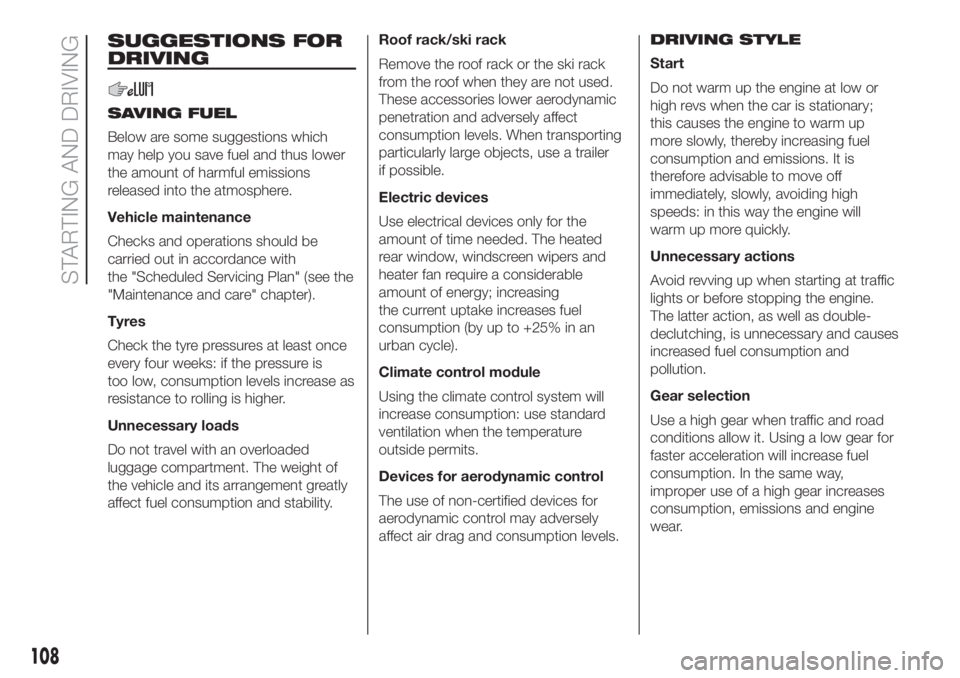
SUGGESTIONS FOR
DRIVING
SAVING FUEL
Below are some suggestions which
may help you save fuel and thus lower
the amount of harmful emissions
released into the atmosphere.
Vehicle maintenance
Checks and operations should be
carried out in accordance with
the "Scheduled Servicing Plan" (see the
"Maintenance and care" chapter).
Tyres
Check the tyre pressures at least once
every four weeks: if the pressure is
too low, consumption levels increase as
resistance to rolling is higher.
Unnecessary loads
Do not travel with an overloaded
luggage compartment. The weight of
the vehicle and its arrangement greatly
affect fuel consumption and stability.Roof rack/ski rack
Remove the roof rack or the ski rack
from the roof when they are not used.
These accessories lower aerodynamic
penetration and adversely affect
consumption levels. When transporting
particularly large objects, use a trailer
if possible.
Electric devices
Use electrical devices only for the
amount of time needed. The heated
rear window, windscreen wipers and
heater fan require a considerable
amount of energy; increasing
the current uptake increases fuel
consumption (by up to +25% in an
urban cycle).
Climate control module
Using the climate control system will
increase consumption: use standard
ventilation when the temperature
outside permits.
Devices for aerodynamic control
The use of non-certified devices for
aerodynamic control may adversely
affect air drag and consumption levels.DRIVING STYLE
Start
Do not warm up the engine at low or
high revs when the car is stationary;
this causes the engine to warm up
more slowly, thereby increasing fuel
consumption and emissions. It is
therefore advisable to move off
immediately, slowly, avoiding high
speeds: in this way the engine will
warm up more quickly.
Unnecessary actions
Avoid revving up when starting at traffic
lights or before stopping the engine.
The latter action, as well as double-
declutching, is unnecessary and causes
increased fuel consumption and
pollution.
Gear selection
Use a high gear when traffic and road
conditions allow it. Using a low gear for
faster acceleration will increase fuel
consumption. In the same way,
improper use of a high gear increases
consumption, emissions and engine
wear.
108
STARTING AND DRIVING
Page 111 of 228
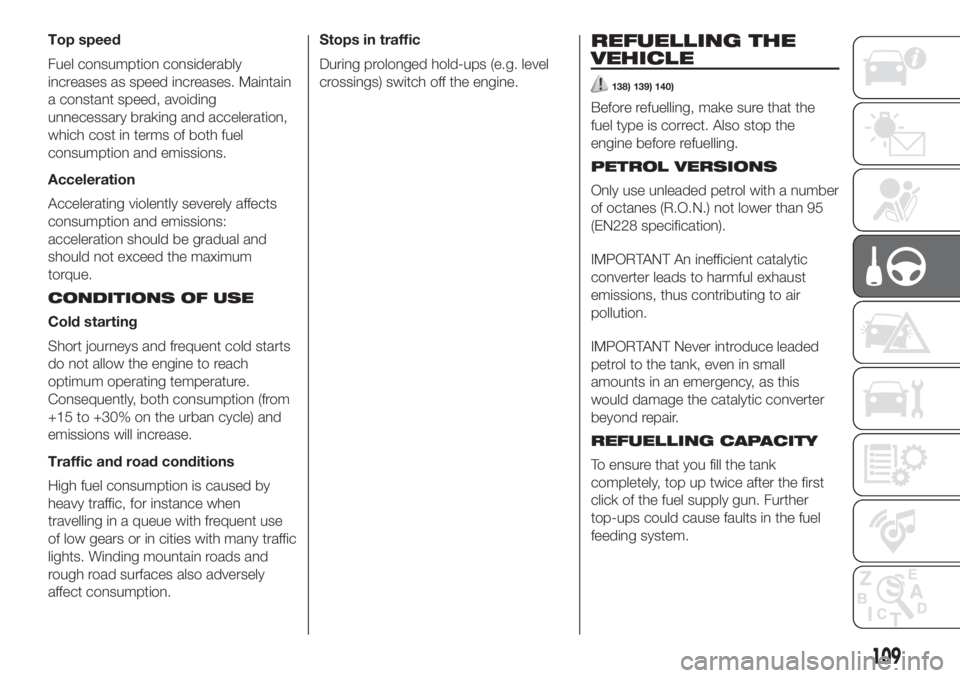
Top speed
Fuel consumption considerably
increases as speed increases. Maintain
a constant speed, avoiding
unnecessary braking and acceleration,
which cost in terms of both fuel
consumption and emissions.
Acceleration
Accelerating violently severely affects
consumption and emissions:
acceleration should be gradual and
should not exceed the maximum
torque.
CONDITIONS OF USE
Cold starting
Short journeys and frequent cold starts
do not allow the engine to reach
optimum operating temperature.
Consequently, both consumption (from
+15 to +30% on the urban cycle) and
emissions will increase.
Traffic and road conditions
High fuel consumption is caused by
heavy traffic, for instance when
travelling in a queue with frequent use
of low gears or in cities with many traffic
lights. Winding mountain roads and
rough road surfaces also adversely
affect consumption.Stops in traffic
During prolonged hold-ups (e.g. level
crossings) switch off the engine.REFUELLING THE
VEHICLE
138) 139) 140)
Before refuelling, make sure that the
fuel type is correct. Also stop the
engine before refuelling.
PETROL VERSIONS
Only use unleaded petrol with a number
of octanes (R.O.N.) not lower than 95
(EN228 specification).
IMPORTANT An inefficient catalytic
converter leads to harmful exhaust
emissions, thus contributing to air
pollution.
IMPORTANT Never introduce leaded
petrol to the tank, even in small
amounts in an emergency, as this
would damage the catalytic converter
beyond repair.
REFUELLING CAPACITY
To ensure that you fill the tank
completely, top up twice after the first
click of the fuel supply gun. Further
top-ups could cause faults in the fuel
feeding system.
109
Page 112 of 228
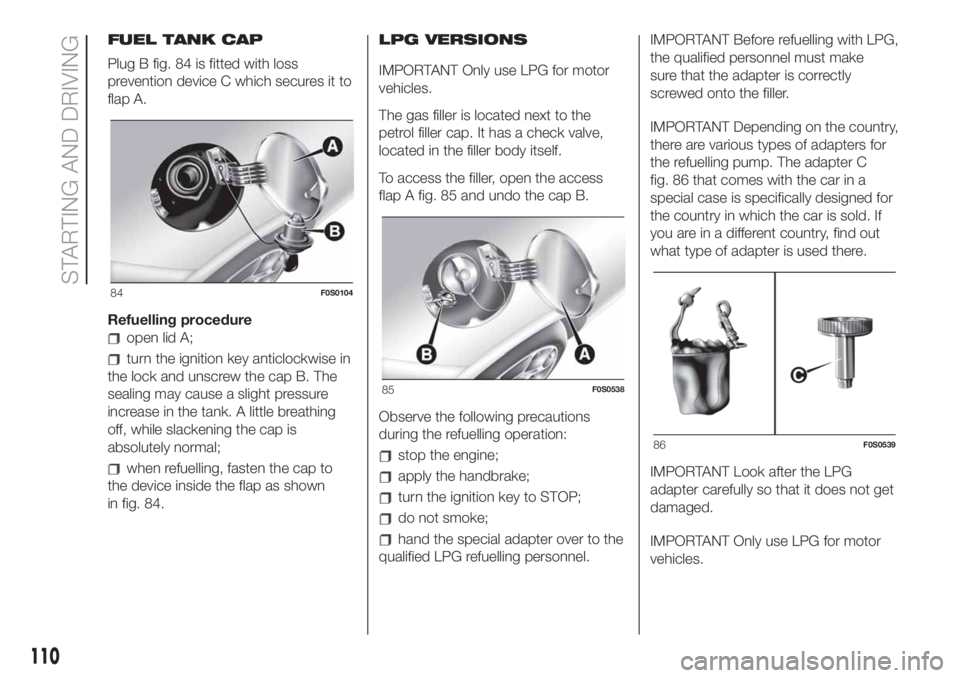
FUEL TANK CAP
Plug B fig. 84 is fitted with loss
prevention device C which secures it to
flap A.
Refuelling procedure
open lid A;
turn the ignition key anticlockwise in
the lock and unscrew the cap B. The
sealing may cause a slight pressure
increase in the tank. A little breathing
off, while slackening the cap is
absolutely normal;
when refuelling, fasten the cap to
the device inside the flap as shown
in fig. 84.LPG VERSIONS
IMPORTANT Only use LPG for motor
vehicles.
The gas filler is located next to the
petrol filler cap. It has a check valve,
located in the filler body itself.
To access the filler, open the access
flap A fig. 85 and undo the cap B.
Observe the following precautions
during the refuelling operation:stop the engine;
apply the handbrake;
turn the ignition key to STOP;
do not smoke;
hand the special adapter over to the
qualified LPG refuelling personnel.IMPORTANT Before refuelling with LPG,
the qualified personnel must make
sure that the adapter is correctly
screwed onto the filler.
IMPORTANT Depending on the country,
there are various types of adapters for
the refuelling pump. The adapter C
fig. 86 that comes with the car in a
special case is specifically designed for
the country in which the car is sold. If
you are in a different country, find out
what type of adapter is used there.
IMPORTANT Look after the LPG
adapter carefully so that it does not get
damaged.
IMPORTANT Only use LPG for motor
vehicles.
84F0S0104
85F0S0538
86F0S0539
110
STARTING AND DRIVING
Page 114 of 228
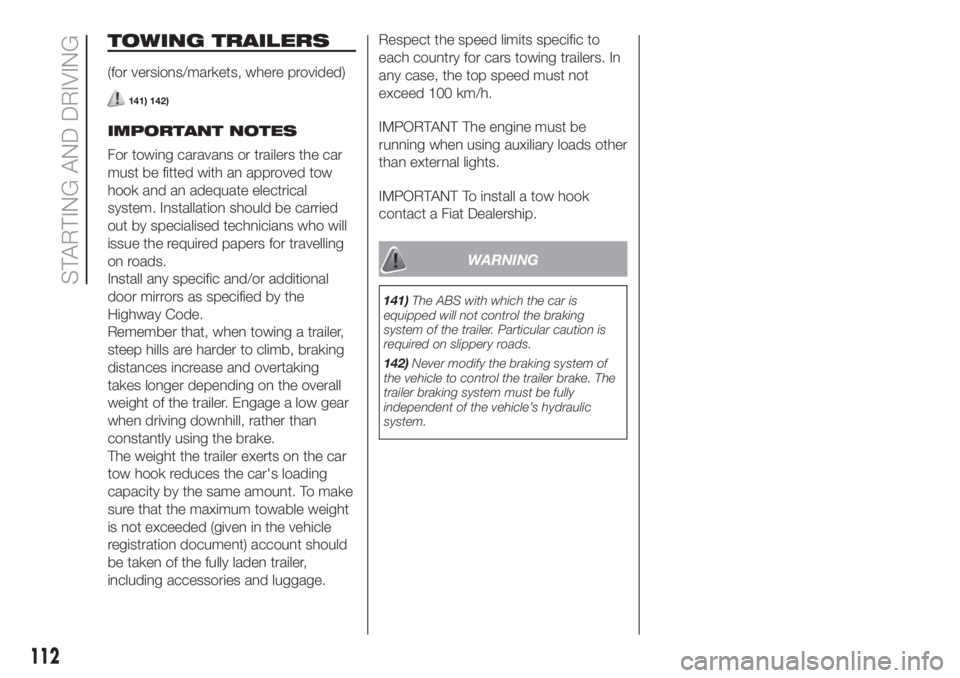
TOWING TRAILERS
(for versions/markets, where provided)
141) 142)
IMPORTANT NOTES
For towing caravans or trailers the car
must be fitted with an approved tow
hook and an adequate electrical
system. Installation should be carried
out by specialised technicians who will
issue the required papers for travelling
on roads.
Install any specific and/or additional
door mirrors as specified by the
Highway Code.
Remember that, when towing a trailer,
steep hills are harder to climb, braking
distances increase and overtaking
takes longer depending on the overall
weight of the trailer. Engage a low gear
when driving downhill, rather than
constantly using the brake.
The weight the trailer exerts on the car
tow hook reduces the car's loading
capacity by the same amount. To make
sure that the maximum towable weight
is not exceeded (given in the vehicle
registration document) account should
be taken of the fully laden trailer,
including accessories and luggage.Respect the speed limits specific to
each country for cars towing trailers. In
any case, the top speed must not
exceed 100 km/h.
IMPORTANT The engine must be
running when using auxiliary loads other
than external lights.
IMPORTANT To install a tow hook
contact a Fiat Dealership.
WARNING
141)The ABS with which the car is
equipped will not control the braking
system of the trailer. Particular caution is
required on slippery roads.
142)Never modify the braking system of
the vehicle to control the trailer brake. The
trailer braking system must be fully
independent of the vehicle’s hydraulic
system.
112
STARTING AND DRIVING
Page 115 of 228
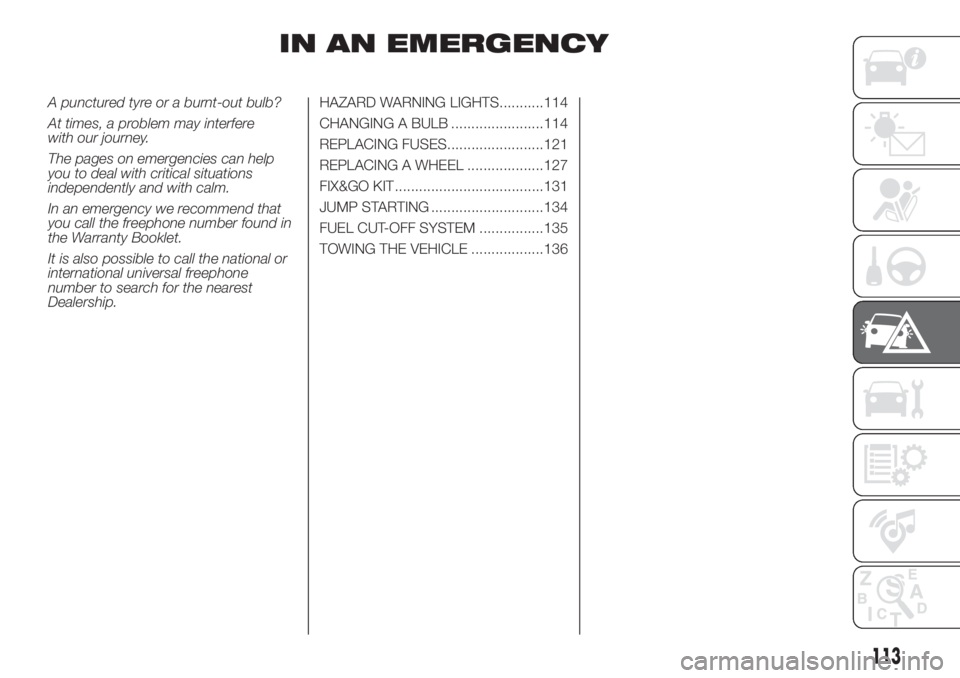
IN AN EMERGENCY
A punctured tyre or a burnt-out bulb?
At times, a problem may interfere
with our journey.
The pages on emergencies can help
you to deal with critical situations
independently and with calm.
In an emergency we recommend that
you call the freephone number found in
the Warranty Booklet.
It is also possible to call the national or
international universal freephone
number to search for the nearest
Dealership.HAZARD WARNING LIGHTS...........114
CHANGING A BULB .......................114
REPLACING FUSES........................121
REPLACING A WHEEL ...................127
FIX&GO KIT .....................................131
JUMP STARTING ............................134
FUEL CUT-OFF SYSTEM ................135
TOWING THE VEHICLE ..................136
113
Page 116 of 228
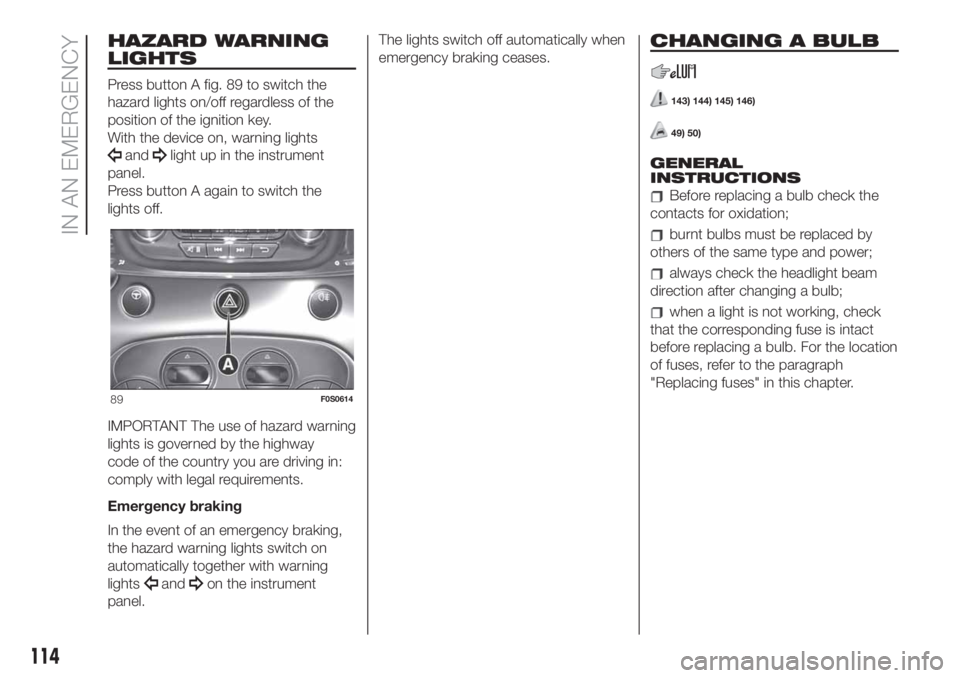
HAZARD WARNING
LIGHTS
Press button A fig. 89 to switch the
hazard lights on/off regardless of the
position of the ignition key.
With the device on, warning lights
andlight up in the instrument
panel.
Press button A again to switch the
lights off.
IMPORTANT The use of hazard warning
lights is governed by the highway
code of the country you are driving in:
comply with legal requirements.
Emergency braking
In the event of an emergency braking,
the hazard warning lights switch on
automatically together with warning
lights
andon the instrument
panel.The lights switch off automatically when
emergency braking ceases.
CHANGING A BULB
143) 144) 145) 146)
49) 50)
GENERAL
INSTRUCTIONS
Before replacing a bulb check the
contacts for oxidation;
burnt bulbs must be replaced by
others of the same type and power;
always check the headlight beam
direction after changing a bulb;
when a light is not working, check
that the corresponding fuse is intact
before replacing a bulb. For the location
of fuses, refer to the paragraph
"Replacing fuses" in this chapter.
89F0S0614
114
IN AN EMERGENCY
Page 117 of 228
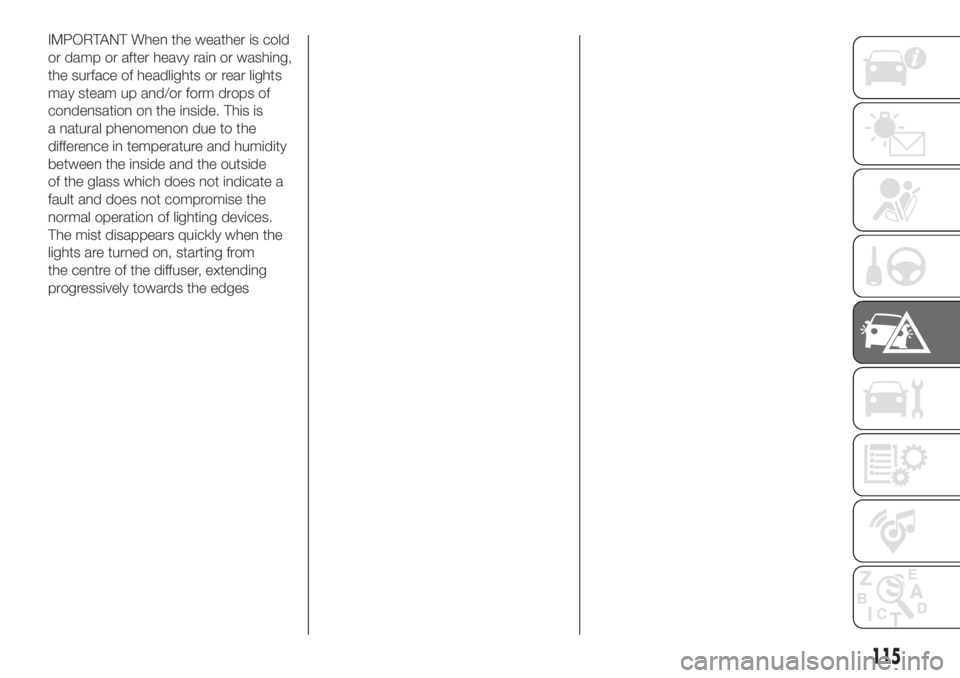
IMPORTANT When the weather is cold
or damp or after heavy rain or washing,
the surface of headlights or rear lights
may steam up and/or form drops of
condensation on the inside. This is
a natural phenomenon due to the
difference in temperature and humidity
between the inside and the outside
of the glass which does not indicate a
fault and does not compromise the
normal operation of lighting devices.
The mist disappears quickly when the
lights are turned on, starting from
the centre of the diffuser, extending
progressively towards the edges
115